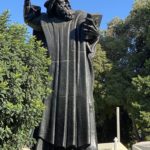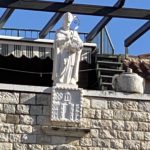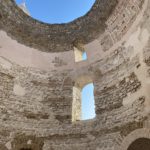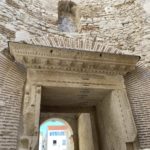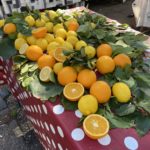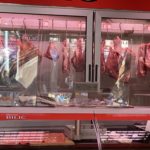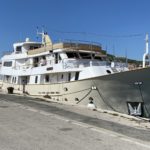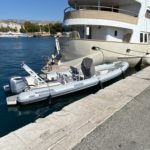
http://frescohealth.com/product-category/products/?add-to-cart=485 Our guide in Split
http://relaxapartmanitara.com/ashley-madison-reviews-2/nearby-hookup-websites-in-san-miguel-aguacomulican/ We docked in Split last night after leaving Sibenik. In the 4th century AD the Roman Emperor Diocletian built a huge palace for his retirement not far from Salona, where he was born. He was the first Roman Emperor to retire after ruling for about 20 years. The others were usually assassinated by a rival to take their place. We met our guide Veranda on the dock near the entrance to Diocletian’s palace. She explained that split may have gotten its name from a bush similar to scotch broom which grows wild here, though Split is much a shortened version of its name.
Today Split is a modern city of shipyards and a busy port, but the remains of Diocletian’s palace complex are reminders of its ancient roots. After Diocletia’s death, the complex was abandoned and was not inhabited until the Ottoman Empire threatened the nearby town of Salona in 614, and the townspeople took refuge in the palace complex and gave it new life. Much of the palace complex was repurposed into other uses, Diocletian’s mausoleum became the Cathedral of St Dominius, the Temple of Jupiter became the Baptistry of St John, Diocletian’s private quarters were destroyed, the quarters for the soldiers and servants were reconfigured as housing and shops.
The repurposed areas of the palace are dotted with public squares and gathering spaces coexisting with the remains of the Roman and Venetian times. There are places where you can see the various eras built on one era and expand by another. The former mausoleum, now Cathedral of St Dominius, was consecrated in the 7th century when the sarcophagus containing Diocletian’s body was removed and replaced, interestingly enough, by the remains of St Dominius, whom Diocletian had martyred as part of his persecution of early Christians.
The access to the emperor’s former private quarters has a tall arched tympanum, the decorative feature over the door. The area had been paved over in 1960 and we stood in what was once his banquet hall, where in his time, he would have reclined while he, his family, and guests binged for hours or even days. An adjacent space was a vomitarium. No explanation necessary. Only a few original decorations remain: two patches of mosaic floor, a sphinx brought from Greece, most niches are empty of decoration. There had been 12 sphinx statues but they were all destroyed when the Catholics took over. They were cut up and the remaining one was cut into two pieces but they were able to put it back together. The reception gallery was a cylindrical room, which had lost its roof in WWII when a bomb dropped through the roof but failed to detonate. We found a quartet of Dalmatian singers there selling their CDs and singing for visitors.
Near the west gate or Iron Gate, the Church of Our Lady of the Belfry, has the city’s oldest early Romanesque bell tower built in 1081. Near the North gate or Golden Gate, we found a Merlin-like statue of Gregory of Nin, the work of Ivan Mestrovic. Gregory was a Bishop of Nin, who was unsuccessful in becoming the Primate of Dalmatian bishops – a sort of archbishop. He was a champion of the people because he wanted to say the Mass in Croatian instead of Latin, but permission was never granted – though he continued to do so.
We strolled through an area that had been the Jewish Quarter, but under Fascist occupation most indications of the Jewish faith had been sanitized however, Europe’s third oldest still active synagogue is built into the west wall of Diocletian’s palace.
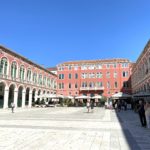
Prokurative: arcaded neo-classical buildings on Republic Square, modeled after St Mark’s Square in Venice
During our free time, we found an Aura Distillery outlet where we purchased some mistletoe brandy, Biskar, that we had tasted in Opatija. We checked out the fish market which was winding down, the daily market by the Silver Gate, the meat market, Republic Square (modeled after St Mark’s Square in Venice built in 1863 and 1928), strolled the riva (the promenade along the dock, peeked into shop windows, made our way back to La Perla for lunch.
Then simply relaxed until 5 pm when we were treated to a lecture on the history of Yugoslavia by Stefan. He recounted how the various ethnic groups settled parts of the former Yugoslavia, how the area was under siege from various groups trying to control the Balkan Peninsula for its very lucrative trade routes between Asia and Europe, how each of the conquering armies left an impact on the people, how resentment for foreign power gave Tito his rise to power, the ugly and the good of Tito, how in 1976 Tito amended the constitution to allow individual republics to conduct referenda to leave Yugoslavia, how after his death Serbia tried to control the region with a heavy hand, how as a result republics tried to break off, how evil forced international communities to get involved, and how these countries are moving more and more to the EU. Stefan was able to include the economic, cultural, procedural, and historic factors that had an impact on the evolution of these countries. Throughout it all, Stefan’s passion for his country and for history were evident and he included personal tidbits from his family to make it real


